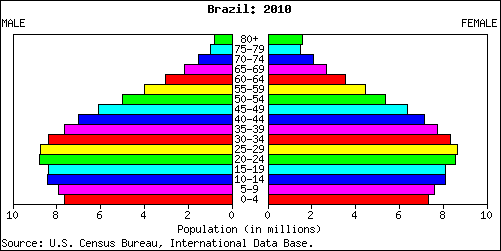By viewing the current state of Brazil, I predict that Brazil's population will grow in the next coming up years from 20 to 50 years. But there is low fertility rate and in the long-run, this will have a negative effect on Brazil's population because population will decrease gradually over a period of time and this may put the nation's future into danger as there will be lack of development which only humans are capable of doing. Brazil's approximate life expectancy is about 75.5 years. A male's life expectancy at birth is about 68 years while a female's is 76 which is more. An average male person's life is shorter and this may affect the future population.
Brazil's fertility rate is 2.18 children born/woman (2011). It has declined from previous data and years. This means that there will be more existence of old people and the young generation will start to disappear just like the old people. There will be fewer people to run the economy and the population will keep decreasing year by year.
Brazil's fertility rate is 2.18 children born/woman (2011). It has declined from previous data and years. This means that there will be more existence of old people and the young generation will start to disappear just like the old people. There will be fewer people to run the economy and the population will keep decreasing year by year.
Sources:

